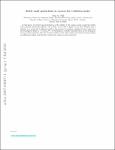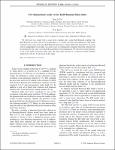Search
Author
- W. F. Kao (1)
Subject
- Cosmology and Nongalac... (2)
- General Relativity and... (2)
- Alternative gravity th... (1)
- General relativity (1)
- next >
Has File(s)
- true (3)
Search Results
We study a recent proposed Ricci-inverse gravity, which is a very novel type of fourth-order gravity. In particular, we are able to figure out both isotropically and anisotropically inflating universes to this model. More interestingly, these solutions are free from a singularity problem. However, stability analysis based on the dynamical system method shows that both isotropic and anisotropic inflation of this model turn out to be unstable against field perturbations. This result indicates that the Ricci-inverse gravity might not be compatible with the inflationary phase of the universe. |
In this paper, we extend our investigation of the validity of the cosmic no-hair conjecture within non-canonical anisotropic inflation. As a result, we are able to figure out an exact Bianchi type I solution to a power-law {\it k}-inflation model in the presence of unusual coupling between scalar and electromagnetic fields as −f2(ϕ)FμνFμν/4. Furthermore, stability analysis based on the dynamical system method indicates that the obtained solution does admit stable and attractive hairs during an inflationary phase and therefore violates the cosmic no-hair conjecture. |
We will focus on a model with a scalar-vector coupling and a scalar Kalb-Ramond coupling. The Kalb-Ramond two-form is known to be equivalent to a
U
1
gauge one-form in five dimensions. The model with both scalar-vector and scalar Kalb-Ramond interactions is hence effectively equivalent to an action with two independent vector fields. As a result, a new set of spherically symmetric black hole solutions will be presented for the scalar-vector Kalb-Ramond theory in five dimensions. We will show that the presence of the scalar fields and gauge fields affect the black hole structure in a nontrivial manner. Related implications will also be discussed in this paper. |



